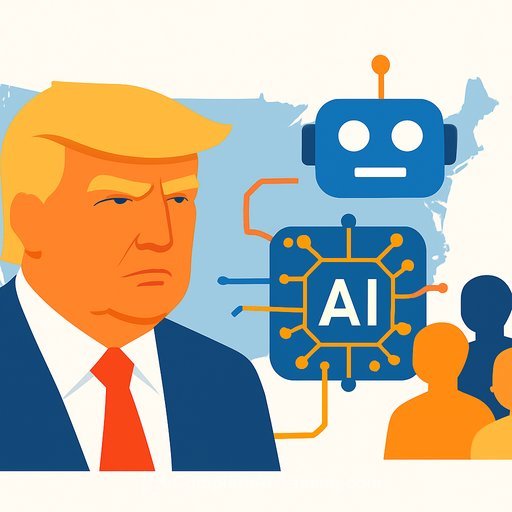Stargate: A $500B AI Joint Venture That Puts Antitrust Front and Center
On Jan. 21, 2025, the administration announced "Stargate," a $500 billion joint venture to build massive AI data centers across the U.S. The partnership brings together OpenAI, Oracle, SoftBank, Nvidia, Microsoft, Arm, and Abu Dhabi-backed MGX, with visible support from federal officials and praise from key lawmakers.
The pitch: pool capital and capability to build 10 gigawatts of compute. The legal question: does combining direct and potential rivals in AI infrastructure violate the Sherman and Clayton Acts-particularly when the project concentrates chips, cloud, and procurement under one roof?
Why legal teams should care
Stargate is not a routine technology partnership. It consolidates market power at the infrastructure layer-chips and cloud-where concentration is already high. If left unchecked, the structure can dampen price competition, mute mavericks, and set the terms for model and app markets above it.
If your clients buy compute, build models, or compete in adjacent markets, the rules set by this JV will shape their costs, access, and bargaining power. If your clients are in the JV, antitrust guardrails are not optional-they're survival gear.
What we know about Stargate
- Participants: OpenAI, Oracle, SoftBank, Nvidia, Microsoft, Arm, and MGX (Abu Dhabi).
- Scope: up to $500B of AI infrastructure, targeting ~10 GW of capacity by end of 2025.
- Projects: Abilene, TX megacenter (~1.2 GW), plus multi-gigawatt builds in Texas, New Mexico, Michigan, Ohio.
- Roles (as publicly described): Oracle and OpenAI as builders/operators; Nvidia as primary GPU supplier; Microsoft as a "key technology partner" and likely tenant; SoftBank entities building shells and grid hookups; Arm providing IP.
Political posture is favorable. Despite the scale and the overlap among participants, there's been scant pushback in Congress and no visible federal challenge to date.
The antitrust frame: where the risk sits
Clayton Act §7-threat to future competition
Section 7 bars acquisitions and combinations whose effect "may be substantially to lessen competition." You don't need present harm; a credible risk to future competition is enough. The elimination of a "maverick" competitor is classic evidence of likely harm.
Applied here: Oracle has priced aggressively in cloud. Inside Stargate, it could align with Microsoft's pricing and terms, removing a disruptive constraint. Likewise, Microsoft and others have been developing custom chips to counter Nvidia and Arm. Joint planning and shared incentives could soften or delay those entry efforts.
Comparable logic drove the government's intervention against proposed Nvidia-Arm tie-ups in 2021: even without identical products, the combination threatened potential competition and downstream customers.
Sherman Act §1-agreements that restrain trade
Section 1 prohibits agreements that unreasonably restrain trade. Joint ventures among competitors are reviewed under the rule of reason, weighing procompetitive benefits against likely harms.
- Independent decision-making risk: If Arm, Nvidia, Microsoft, Oracle, and OpenAI coordinate on product roadmaps, capacity, or pricing frameworks through the JV, they reduce the number of independent centers of decision-making-exactly the concern Section 1 targets.
- Hub-and-spoke exposure: A central JV can facilitate indirect coordination among members on pricing, discounts, or capacity (even without a single explicit cartel agreement).
- Information exchanges: Sharing sensitive data on GPU supply, cloud pricing, large-customer deals, or future capacity plans can chill rivalry.
Procompetitive claims-efficiencies, scale, energy procurement-will be argued. But efficiencies must be merger-specific, verifiable, and passed through to customers. "Bigger and cheaper for us" isn't enough.
Read Clayton Act §7 | FTC/DOJ Guidelines for Collaborations Among Competitors
Market structure matters: why infrastructure is the choke point
Models and applications are crowded with entrants. Infrastructure is not. A few cloud providers control the majority of capacity. Nvidia dominates high-end GPUs. Arm's IP is deeply embedded. TSMC holds a large share of advanced manufacturing.
Stargate concentrates purchasing and supply decisions across these layers. That raises the odds of coordinated outcomes on price, supply allocation, and product interoperability-effects that ripple up to models and apps.
Conduct that will draw scrutiny
- Exclusive supply or "first call" rights to GPUs or IP that starve non-members of access or delay deliveries.
- Most-favored-nation clauses and parity commitments that lock in high pricing or uniform terms across major buyers.
- Capacity planning that quietly tracks rival output and staggers expansions to preserve pricing.
- Standard-setting via the JV that bakes in member-favored interfaces, disadvantaging independent chip or cloud entrants.
- Cross-licensing conditioned on staying out of each other's product lines (market allocation in disguise).
- Procurement practices that depress upstream prices to non-sustainable levels (monopsony) while keeping downstream prices high.
"Government-backed" is not blanket immunity
Political support does not confer antitrust immunity. The state action doctrine requires a clearly articulated policy and active supervision by the state-usually not present for federal industrial policy. Noerr-Pennington protects petitioning, not commercial coordination.
Unless Congress enacts a specific exemption, the JV stands on the same antitrust ground as any other competitor collaboration. Agencies can also challenge post-consummation, even if filings were made and waiting periods expired.
National security and industrial policy: likely arguments, real limits
Expect claims that domestic AI capacity is vital to defense and supply chain stability. Those claims can inform agency discretion and remedies, but they don't erase liability. Courts still ask: could the same benefits be achieved with less harm to competition?
If foreign investment is significant (e.g., MGX), counsel should prepare for CFIUS review and export control overlays. That's a separate track from antitrust, and both need coverage.
What regulators could do
- Demand structural clarity: ownership, voting rights, vetoes, and economic interests of each member.
- Impose behavioral conditions: non-discrimination in access, fair and transparent queueing, and bans on exclusivity for critical inputs.
- Wall off sensitive information: strict firewalls, clean teams, and audited data-access logs.
- Prohibit MFNs and broad parity clauses that standardize pricing across large customers.
- Mandate interoperability and open interfaces to avoid lock-in.
- Require regular reporting on capacity allocations, pricing ranges, and wait times (aggregated to protect trade secrets) to monitor for coordinated effects.
Action items for buyers and rivals
- Contract now for capacity: secure non-discrimination, service-level guarantees, and price-adjustment formulas decoupled from a single supplier's list price.
- Avoid MFNs that freeze you into JV-wide pricing. Push for reopeners if market shares or ownership change.
- Add interoperability clauses to prevent forced migration or hardware lock-in.
- Seek commitments on transparent queueing and delivery windows; include audit rights.
- Document harm: price increases, delays, or feature deprecation post-announcement-all useful for agency outreach.
Compliance guardrails if you're inside the JV
- Define the scope: a narrow, written purpose with clear do's/don'ts. No discussions on outside pricing, roadmaps, or customer terms.
- Install firewalls: clean teams for competitively sensitive information; separate governance for members that compete in adjacent markets.
- Adopt open, non-exclusive supply terms; publish objective access criteria and a queueing policy.
- Ban MFNs and broad exclusivities. Limit any necessary exclusivity by product, region, and time, with independent monitoring.
- Set up real-time antitrust oversight: training, meeting agendas, counsel present, minutes, and compliance audits.
- Establish an ombuds process for third-party complaints and a rapid-remedy protocol.
The political calculus vs. the legal standard
The fanfare focuses on scale, speed, and national pride. The legal standard focuses on whether competition is preserved. With chips and cloud already concentrated, combining major buyers, suppliers, and platform owners under one umbrella raises predictable risks: higher prices, fewer options, and slower independent entry.
That's the core of Singh's critique: the structure doesn't just build capacity-it can coordinate the market that sets the terms for everyone else.
Bottom line
Stargate could deliver real infrastructure. It can also cartelize de facto if governance and conduct drift. For counsel, assume scrutiny-even if it's delayed-and build a record now: narrow scope, strict firewalls, non-discriminatory access, and a paper trail that shows independent decision-making across members.
If you advise buyers, lock in protections before the new terms of trade harden.
Want your team to stay sharp on AI infrastructure and risk? Browse AI courses by job
Your membership also unlocks:






